Demand for software development services keeps growing.
This high demand results in a continuing shortage of good IT talent for full-time work onsite and escalating costs of development services.
The median software developer’s annual salary is $120,730. It will increase by 25% within a decade.
Outsourcing services remain a viable alternative, providing a proven and powerful option for large and small businesses alike.
Entrepreneurs benefit from:
- team-ready expertise
- lower hourly rates
- no hassle and expense of recruiting and onboarding
- no long-term hiring obligation
Yet, the question remains: Which “shore”?
There are several ‘-shore’ options:
Onshore. Offshore. Nearshore.
The division line between is the distance:
- Onshore – close
- Offshore – not close at all
- Nearshore – close enough to be convenient but far enough away to cost less
Is that all? No.
The cultural aspect is essential to any search for a reliable partner.
This guide analyzes different elements of successful nearshore software development.
The goal is to help you balance price, timeline, and quality perfectly.
Check it out!
1
What is Nearshore Software Development?
Do you wonder, “What is nearshore software development?”
Nearshore software development defines a software development company located in a neighboring country to business seeking software development services.
Nearshore software outsourcing takes a geographically middle position between onshoring and offshoring.
When going onshore, a company hires a team in the same country. The term “offshore software development” means a development team is located in another part of the world.
Here is an illustration:
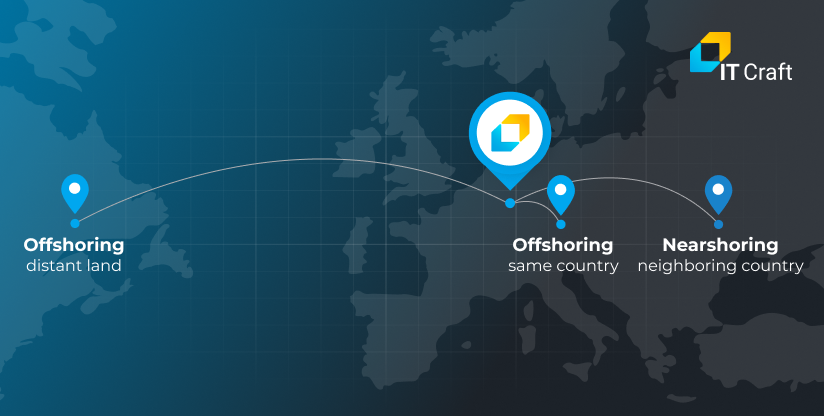
As with onshore and offshore, nearshore software development can be total or partial.
Total. Businesses save their in-house IT department for specific, on-site work, outsourcing an entire software development project to one or more contract software development teams.
Partial. Businesses use the hybrid model. They outsource a single activity (e.g., API development or DevOps) to an external team. The in-house team remains responsible for a specific part of a project.
2
How Different are Offshore and Nearshore Software Development Models?
Technically, the term “nearshoring” derives from offshoring. It describes a situation when businesses opt for custom software development in nearby, low-cost countries.
What are the similarities?
In both cases:
- Businesses retain indirect control over the team.
- They manage a remote team in another company located in another country.
- Communication and regular meetings held between the team and client are digital and virtual.
Why do businesses do this?
By outsourcing to a neighboring country, firms hope to benefit from:
- a lower hourly rate for the same high-quality professional skills
- a higher level of predictability compared to an offshore country
This approach is possible through speaking the same language, sharing cultural practices, and historical links from a common past.
3
What are the Pros and Cons of Nearshore Software Development?
Businesses benefit from a better understanding of the culture and mentality of contract developers. Both company and contractor work in the same or similar time zones. This provides greater efficiency.
Pros include:
1. Access to a wider pool of technical experts
Nearshoring grants access to a wide talent pool of skilled professionals. For instance, Ukraine offers 300K+ tech experts. (Over this past year, there has been an increase in highly qualified tech experts.) Your business can pay a reasonable price for a development team working without micromanagement.
2. Travel proximity
Unfortunately, this applies to an open, peaceful world. As soon as traveling is safe and permitted, face-to-face communication will be back on the table. There are regular, direct flights between you and your team’s country. No visas or special permits are required to visit each other. It takes only 3 – 4 hours to get to the destination point. Planning takes little time when you visit your team or your team comes to visit your office. Also, jet lag is not a factor.
3. Sharing the same or similar views, values, and lifestyles
With nearshore software services, there is a higher degree of probability the team shares the same work habits and attitudes as you. Cultural understanding means working from the same or similar “cultural page”:
- Developers better understand you and your goals.
- They correctly interpret requirements and processes.
- The team follows the same managerial approaches.
4. Insignificant time differences
It is easy to stay in touch with your developers during your business hours. Organizing daily meetings inconveniences neither party. No one has to stay at work late or arrive early in the morning to synchronize schedules. Urgent questions are handled quickly because there is no time lag. Similar time zones mean less stress, less fatigue, and fewer burnouts caused by an uncomfortable schedule.
Cons include:
Cons connected to nearshoring are lower compared to offshore outsourcing.
They generally apply to inexperienced service providers:
Nearshore software services are less expensive than either an in-house team or onshore development company. Compared to offshore software services, nearshore services appear more expensive. However, offshore’s lower hourly rates do not mean the lowest overall project total. Factor in increased indirect costs and extended project timeline caused by cultural differences.
Business owners always face the risk of losing control over their business processes. When no in-house specialist understands how the software works, a business can become too dependent on a software development company and lose its stability in the future.
Advice: always keep a reliable product owner in-house and maintain transparency on the project.
When a contractor resides in another country, confidentiality can be an issue. Before choosing a service provider, ask each outsourcing company what security precautions they will apply to your project. Choose a provider that cares about its reputation and can harmonize its security practices with yours.
Always ask for an NDA. Avoid estimates that are much lower than anticipated.
3
How Nearshore Development Works
Flexibility is the key to understanding how nearshoring works.
Software development needs vary. So do partnership models.
During the introduction call, outsourcing vendors discuss project requirements and specific client needs. This ensures they assemble the best development team and finalize cooperation details that fit in with the client’s particular case.
Dedicated team
This option is best for large projects with changing requirements, such as software development for startups. It also works well for small and mid-sized companies with no in-house IT department.
The software development vendor assembles a dedicated team, ensuring all expertise to cover project activities is provided, e.g., project management, design, testing, etc.
The dedicated team acts as the client’s “external” IT department. It coordinates priorities, scope of activities, and deliverables. The team works autonomously and presents the results.
Team augmentation
Companies opt for team augmentation when they already have an in-house team and look for specific expertise, e.g., DevOps, back end, or native Android app development. Depending on project goals, they can assign an entire team or one to several developers.
External developers harmonize their efforts with the client’s team. The client’s manager can supervise single developers. Yet, a dedicated project manager on the vendor’s side works when the scope is large.
Team augmentation also helps balance costs when the scope of work is not enough for a full-time employee.
Managed services
Managed services apply to technical support, software maintenance, and infrastructure management.
An outsourcing team ensures 24/7/365 availability. It tracks software health, scales it, and monitors network and security.
Managed services help clients optimize the costs of night-shift work while increasing software stability.
For greater flexibility, time and material terms work best for most IT projects. Still, clients can negotiate limits on the maximum monthly hours to avoid budget overruns.
The fixed-price model works best for small projects with limited scope, e.g., prototypes.
To ensure the quality of administration and DevOps services, parties sign a service-level agreement where they state the expected output and technical parameters.
5
How do Nearshore Software Development Costs Compare to Onshore and Offshore?
Direct costs of nearshore software outsourcing are higher than those in distant locations:
- Central/Eastern Europe – $30 to $65 per hour
- Western Europe – $65 to $170 per hour
Asian companies are cheaper. Yet, nearshoring is still competitive when looking at onshore companies’ rates:
- USA/Canada – $100 to $250 hourly per hour
- Australia – $100 to $150 hourly per hour
Also, cultural similarities greatly decrease any chance of broken deliveries while cultural differences, inferior quality, and hidden fees in case of distant locations might eliminate any profits.
Therefore, nearshore developers still provide cost-effective services. The overall price is the same or slightly higher than that of an offshore company.
6
What Industries Demand Nearshore Software Development the Most?
Companies keep growing despite economic challenges. Digital solutions save users time and effort. Users work, train, enlighten, and entertain from any location worldwide.
Below are the main industries that benefit the most from nearshore software services:
Healthcare and fitness
Healthcare apps are among the most popular trends. Distant consulting decreases diagnostic time. Using telemedicine, a patient can “visit” a clinic without leaving home. No-show rates decrease too.
Fitness apps help users stay motivated with their daily workout program and achieve their fitness goals at home.
FinTech
Businesses in financing have long acknowledged the transformational power of digital technologies. They need experts in FinTech software development who know how to help modernize antiquated internal systems, deliver new consumer apps, or keep user data and app infrastructure safe.
FinTech
Businesses in financing have long acknowledged the transformational power of digital technologies. They need experts in FinTech software development who know how to help modernize antiquated internal systems, deliver new consumer apps, or keep user data and app infrastructure safe.
Ecommerce
People love to shop online. Development teams help businesses prepare for seasonal sales and promotional campaigns when user demand skyrockets. They also provide website maintenance ensuring secure purchase transactions and uncompromised user experience when interacting with an ecommerce solution.
eLearning
Demand for online learning solutions is high. People from every corner of the world can access online courses by experts and the newest best practices. Nearshore software developers help launch relevant learning solutions, wide-audience and niche, B2B and B2C.
Business process automation
There are proven practices to help businesses replace outdated software with modern systems. Nearshore software outsourcing helps developers share the load and spread the tedium when sorting out an old, badly documented code base.
Logistics
Logistics companies cannot stop updating software and introducing new systems. Why? Because logistics software decreases the workload and the cost of an error. An outsourcing software development team can help automate workflow inside a warehouse. Supply chain management ensures evading idle time.
7
Examples of Outsourced Nearshore Software
Nearshoring companies have been an important part of successful digital products. To name a few world-known products whose owners selected to work with nearshore software development providers:
- Skyscanner to Ukraine
- Revolut to Lithuania
- Wise to Estonia and Ukraine
- InVision to Colombia
- Skype to Estonia
Nearshoring teams have helped startups launch products and eventually grow into global businesses.
Yet, outsourcing to a nearshore team works for different complexity and budget size.
Here are more real-life cases of how IT Craft integrated its teams into the clients’ processes:
RooQi
Dedicated team
RooQi is a next-gen social network. It connects coaches and young athletes in a trusted way. Coaches find top talents for their teams. Athletes receive the best career opportunities.
The IT Craft team worked on MVP development from scratch. The cooperation started with project discovery and vision alignment.
The team:
- analyzed the client’s idea
- clarified requirements
- decided on the best tech stack
- thoroughly estimated project scope
The team developed the core functionality of an iOS app on fixed-price terms. IT Craft engineers did their best to help the client stay within the budget limits.
The client benefited from:
- an MVP launch within the predetermined budget limits
- timely delivery of the app
- flexible architecture for future feature expansion and scaling
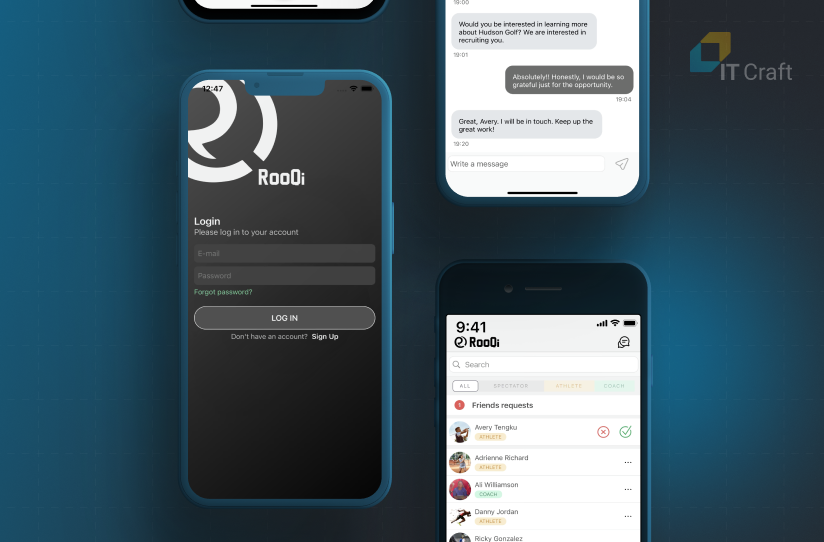
Predira
Dedicated team
Predira is a white-label builder enabling traders to start trades under their brand quickly and flexibly. The client applied the already-acquired industry experience, expanding to a new niche.
The IT Craft developers started with a limited project scope that expanded when the client decided on project facilitation.
The team:
- focused on mastering the offered tech stack
- focused on mastering the offered tech stack
The team launched a flexible MVP platform, ensuring the client got the best deliverables for his investment. It is available on the Web.
The client benefited from:
- team’s experience with his other project
- slow project start helped clarify the scope and feature list
- weekly releases enabled keeping the project pace
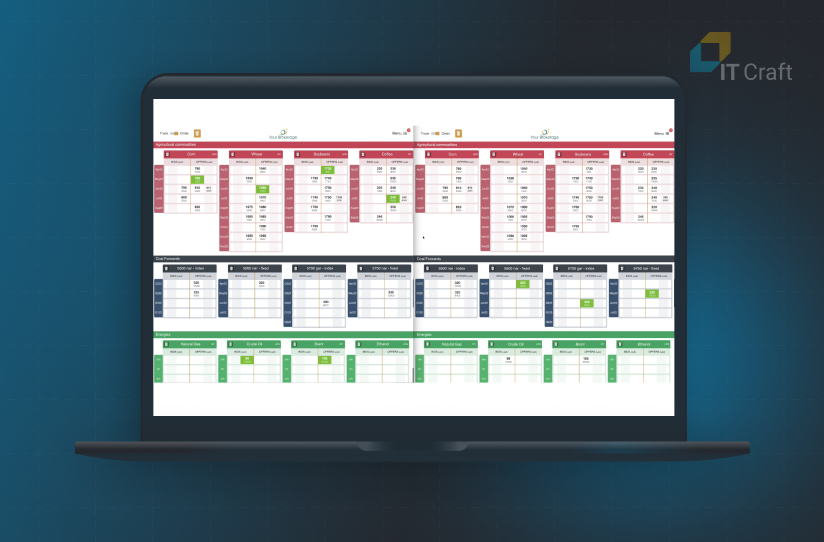
MyPlace Connect
Team augmentation
MyPlace Connect helps use guest Wi-Fi for marketing activities. Businesses collect user feedback, provide personalized offers, and analyze statistics via a special Wi-Fi CRM.
IT Craft focused on DevOps services, infrastructure optimization, and software maintenance.
The team:
- started with a software audit
- determined a list of improvements
- migrated to new cloud infrastructure
- improved software monitoring system.
System stability and performance increased. Infrastructure improved. It scales as needed.
The client benefited from:
- timely consultancy on requirement implementation
- practical steps to seamless migration
- regular server updates and monitoring
- no software downtime
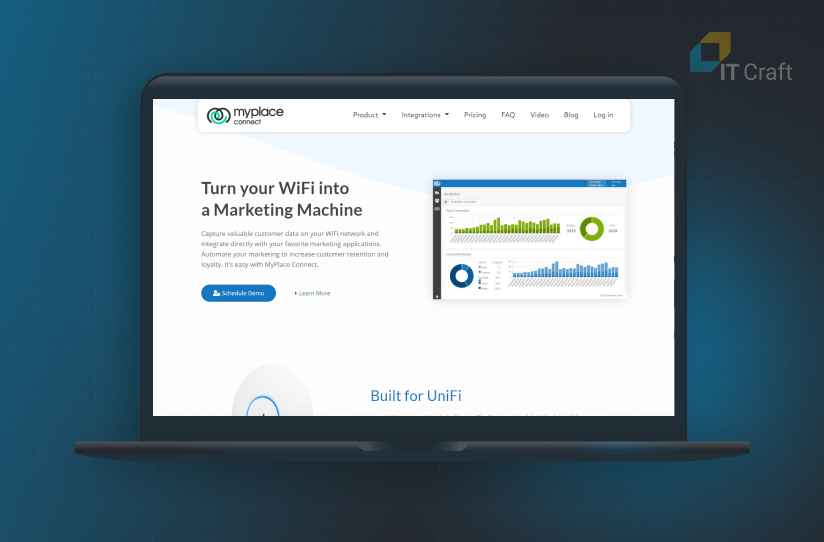
8
How to Find the Best Nearshore Software Developers in Five Steps?
Finding programmers when you search for offshore or nearshore software development is often challenging and time consuming.
Challenging, but possible.
Below is a five-step path to help you navigate through nearshore software services:
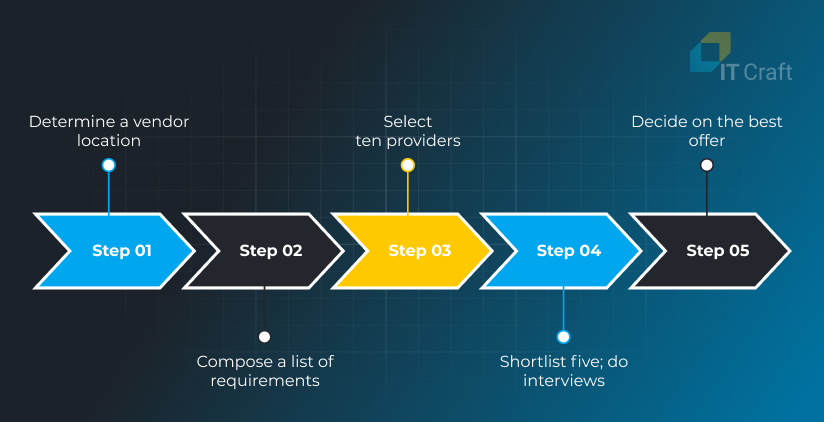
01. Determine vendor location, a time zone and destination best suited for you.
Some countries (e.g., Canada, the USA, Brazil) lie in several time zones. The time difference between Vancouver, B.C. (Canada) and Rio de Janeiro (Brazil) is five hours. This can hardly be called nearshoring software development. At the same time, there is a one-hour difference between London (Great Britain) and Warsaw (Poland) and a two-hour difference between Dublin (Ireland) and Kyiv (Ukraine). Both sound nearshore.
Look in which part of the country the provider resides or broaden your search parameters.
02. Make a list of requirements.
Compose a feature list from the most to least important. Determine the desired timeline. Save the feature list and use it when interviewing shortlist of possible companies.
No idea how to compose a list of requirements? No problem.
Write down your aims and what you envision—be as specific as possible. Ask the companies to estimate timeline and cost.
03. Search for the top ten providers.
After you have chosen your vendor destination and have a feature list, make a list of the top ten companies.
Use Clutch, Upwork, or LinkedIn. Study feedback from clients and company profiles. Look at their websites to read about their portfolios and services to understand each company’s experience and strong points. Write down ten companies you like the most.
04. Shortlist five and schedule interviews.
Select your top five companies. Send your list of requirements from step two to these five companies. Schedule an interview with each company. Study their reaction to your questions. How quickly do they respond? Do they provide a free estimate? Do they want to schedule a call for more precise requirements? Do they show interest in your project? When can they begin?
Send the same requirements to all companies ensuring you can compare results.
05. Pick up the best offer.
After each interview, write down your impressions. Compare interviews. Assign points for each component (elaboration of requirements, understanding of your project, feedback, budget and timeline, level of interest, etc.)
Choose the team with the most points. Ensure they can handle your priorities. Also, ensure you choose the best quality-for-price ratio.
Choose a nearshore software outsourcing company that provides you with:
- Expertise – The development team has successfully completed similar projects. They know how to handle your priorities. They know where possible pitfalls lie and how to avoid them.
- Cultural fit – The development team understands you and your goals. They know what you value and what you expect from an established workflow.
- Transparency – There are no hidden costs for you. The team is clear about the project's progress. You get what you expect when you expect and for the agreed price.
- Flexibility – The team does not blindly follow requirements when the client needs a pivot. Instead, they switch to real project priorities.
9
What Makes IT Craft a Reliable Nearshore Software Development Company?
- technical expertise
- cultural awareness
- positive attitude

They make IT Craft a go-to nearshore software development company for EU businesses and a long-term, trusted partner for many US companies.
Company and country culture matters.
At IT Craft, cultural nearshoring matters the most. The company offers a predictable workflow helping companies in the EU, North America, and Australia launch their software with minimum stress and a lower budget.
Here is how we do it:
Immediate start
IT Craft has several departments. We find a team that fits your project best. No time is wasted. Once we have agreed upon the project scope, timeline, and payment plan, we sign a contract. The team starts working.
Adherence to promises
IT Craft is known for its high-quality, on-time project deliveries. It cares about its reputation. Client satisfaction is the top priority. We deliver on our promises, helping you go an optimum path to your goal.
Instant response
You can always reach out to your dedicated business development manager and project manager to discuss project progress. You can ask them any urgent question; they respond fast within business hours.
Knowledge transfer
Project documentation receives regular updates. The source code has commentaries. Several people have project knowledge, ensuring that nothing gets lost.
Proactive development
The team delivers a project keeping “why” in mind. You get source code you can easily maintain and extend with new features in the future.
Transparent delivery
Project progress is portioned. You discuss a plan before a Sprint and get a report after it. You test launched functionality. You know exactly what your team is doing.
!
In Conclusion: Choose wisely
Offshore and nearshore software development differ in the distance between the client’s and the vendor’s country. Offshore and nearshore have their own benefits and downsides. Still, businesses work with a team in each particular case.
In each partnership, cultural fit is crucial for a successful software launch. This saves businesses from long, tedious explanations and clearances. Eastern and Central Europe provide an enticing destination for the EU and US companies sharing similar mindsets and values.








